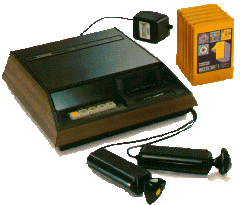
Fairchild Video Entertainment System/Channel F (System 1/System2)

![]()
YEAR 1976 COUNTRY U.S.A.
Model# FVE100 Codename N/A CPU Fairchild F8 SPEED 2Mhz COPROCESSORS 3851, 3852, 3853, 3854, 3856, 3857 (see below). ROM Cartridge based programs RAM 64 bytes GRAPHIC Modes N/A COLORS N/A SOUND N/A I/O Ports/Addons hardwired RF connector, 2 controllers (System 1 - hardwired, System 2 - removeable), onboard speaker (system 1), hardwired AC adaptor.
![]()
The console that changed the industry, the Fairchild Channel F has the distinction of being the first commercially released console that used programmable cartridges.
With the pong market booming, and manufacturers releasing more elaborate pong units, the market was getting oversaturated by 1976.
Sometime in 1975, Fairchild Semiconductor, or it's parent organization Fairchild Camera and Instrument Corporation, decided to enter the home video game market with their own unit. What it came up with was a unique cpu based programmable console. Started in 1957 by Sherman Mills Fairchild under the umbrella of his Fairchild Semiconductor in itself was well known as one of the pioneers in semiconductor research (Gordon Moore and Robert Noyce, co-founders of Intel got their start there).
The Channel F was to be designed around Fairchild's own F8 microprocessor (which was actually a CPU and several support processors that all together are called the "F8"). The technical specifications of the F8 can be found here.
The Channel F's overall look and design is a mixture of the then current pong console designs and some original ideas. Most easily recognizable is the 1970's standard issue woodgrain and a record player like smoked plastic dust cover covering a storage area. The similarities stopped there.
Detached controllers were just starting to appear that year on pong units - instead of mounting the dials directly on the unit (leading to hunching over if you're sitting on the floor in front of the TV), pong players could now sit back and use the same knobs mounted on handheld controllers. The Channel F took this one step further. Using a more easily held "grip sticks" design mounted on the top was a triangular shapped moveable addition that could be moved in four directions like a joystick, twisted to function like standard pong dials, and pressed directly down to function as a fire button. They were connected to the console through dedicated 8 foot long wires.
Why a 4 direction joystick and fire button in an era of pong games you ask? Because of the next important feature: The Channel F was to be a programmable console. Wildly different than the normally seen and still evolving pong systems which were dedicated to only playing pong games with a multitude of variations at the flick of a switch, this new console would feature plug in cartridges that would contain rom chips with actuall microprocessor code rather than dedicated circuits (which were used in the original Odyssey game system). So instead of a short shelf life common to pong systems, the console could now be continuously renewed with the simple plugging in of a game cartridge. And with the possiblity of new game cartridges released at any time, the lifetime of the console seemed very attractive to Fairchild.
Big whoop you say? "You're just describing videogame cartridges." Ah, but remember - this was 1976. This was THE first. And it established a format that was to be used by everyone even until today where cartridges are finally being phased out for CDrom based consoles, but still the defacto standard for handheld gaming systems such as Nintentdo's Gameboy series.
The games were selected by 4 selected buttons, which also doubled as option setters for single game cartridges. To start the console, you'd turn on the console and tv, insert the cartridge, and then press the reset button (located to the left of the 4 select buttons) to reset the unit and start running the cartridge.
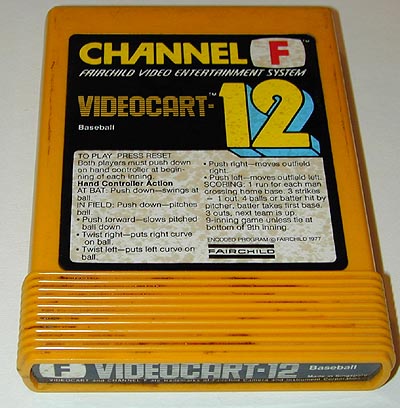
The cartridges themselves were to look like the then popular 8 track tapes, with labels that contained the game instructions on them and a unique number to identify which cartridge number in the series it was. The thinking being that once you get in to double digits it makes the the lineup of games seem much more attractive and sizeable to the user at first glance. It also pushed the consumer towards wanting to collect all the games in a series similar to numbered baseball cards. This numbering format was actually used by many of the other cartridge based consoles that popped up in the late '70's afterwords as well.
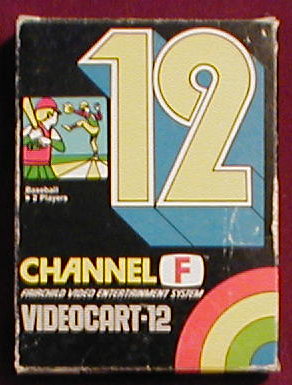
The cartridge boxes (and some of the cartridge labels) were covered with Peter Max (known for the Beatle's Yellow Submarine movie, and the 7UP add's) inspired artwork typical of the late 60's and early to mid 70's.
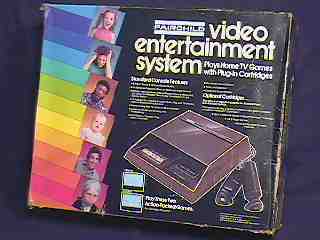
The console box itself would feature an eyecatching raimbow and pictures of people from all walks of life, including probably the first picture of an African Amerian on it - which was also a sign of the changing marketing demographics of the 1970's in entertainment.
So, with all this, the Fairchild Video Entertainment System hit the market in August of 1976. It immediately changed the home gaming industry forever. With dedicated consoles not only flooding the market but now being rendered obsolete, anybody who wanted to compete would have to answer in kind.
Atari had already been developing a cartridge based system (at the same time as Fairchild was developing theirs) it had codenamed Stella, so it was the first to do so but it took almost a little over a year after the release of the Fairchild console to do so. The reason was that when Fairchild hit the market first, Atari founder Nolan Bushnell realized they needed to get theirs to market soon before it become to flooded with "me to's" again like the pong market (which actually didn't occur until 1983-84 and the great Videogame Crash) decided his company needed more capital to be able to finish and market the system to compete. So, it prompted the now legendary sale of Atari to Warner Communications who then sunk money in to Atari to finish the development of their programmable system. Atari released theirs in October of 1977, and decided to call it the Atari Video Computer System (later renamed to the 2600 with the introduction of the 5200 console in 1982) to latch on to the "video system" tag already in the consumers psyche from the Fairchild console.
Fairchild responded in kind by changing the name of their console to the Fairchild Channel F. However, the blocky graphics were starting to show their age already (if you can believe that) when compared against the 2600's higher resolution blocky graphics. Sales were slipping, and in an attempt to cut costs Fairchild also started work on a scaled down model to be called System 2. However, tragedy struck the industry durin Christmas of 1977 in the name of the "first videogame crash".
With the market already flooded with dedicated consoles and now being rendered obsolete by the Channel F and then Atari VCS, dedicated console makers were loosing money fast. So, they drastically slashed prices (so much so that they wouldn't even make the manufacturing price back) just to unload stock and get out of the business. With an overabundance of cheap videogame consoles to choose from (even if 98% weren't programmable) and the now emerging handheld electronic gaming market to further take away market share. In a market situation similar to the "great shakeout" that would appear 6 years later, just about every company making home gaming consoles discontinued them or closed up alltogether. Fairchild was no exception, and they disscontinued the Channel F just after the Christmas season.
By 1978, Fairchild had only released 21 cartridges for the Channel F, and the consoled that had changed home gaming consoles for ever was dead after only a year and 4 months on the market. Or was it?
In 1979, A company by the name of Zircon bought the rights to the Channel F, including all the stock left and the unreleased System II.
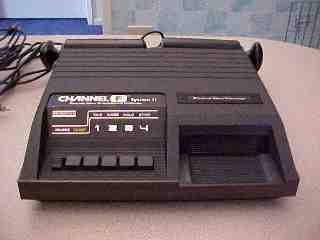
They released 5 new games (some unreleased Fairchild games) and the System II through the early 1980's before finally succumbing to the 2nd crash of '83-'84. Zircon still exists today as a seller of electronic hand tools.
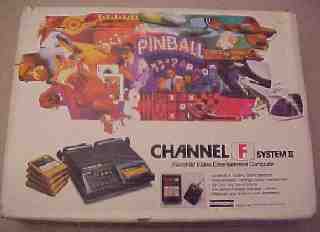
The system was also released overseas as the Luxor Video Entertainment System in Sweden, The grandstand in Great Britain, and Saba Video Play in Germany during the same timeframe. More information will be added here in the future.
USENET NewsGroups
- rec.games.video.classic : General classic gaming discussions
- alt.games.video.classic : General classic gaming discussion
Web Links